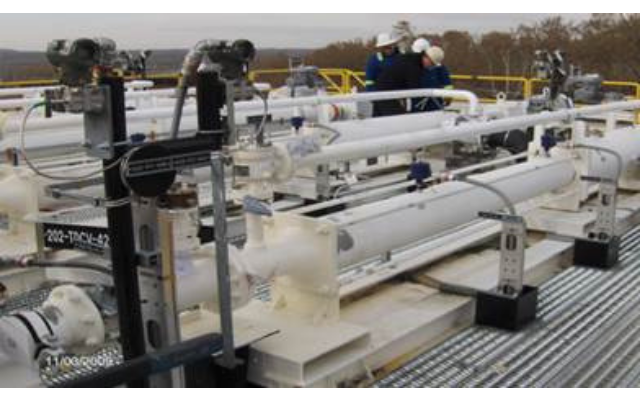When a major Canadian energy transportation company expanded operational infrastructure, they reached out to NETZSCH for a customized pumping solution designed to provide greater operational efficiencies.
By George Balcerczyk
For more than 60 years, a Canadian energy company has been in the business of delivering energy, including oil and gas, across North America. Among the customer’s primary businesses is the operation of the world’s longest crude oil and liquids transportation system, conveying crude oil and other liquid hydrocarbons from the point of supply to refining markets in the mid-western United States and eastern Canada.
Custom Pumping System Required to Prepare Oil for Distribution
The customer recently constructed a new infrastructure project that included the construction of 15 new storage tanks –ranging in size from 250,000 to 530,000 Barrels – with all associated piping, manifolds and booster pumps to facilitate the transfer of crude oil to and from the storage facility, the mainline piping system and other connecting carriers and terminals.
With a goal of reaching the highest operational efficiencies at the storage facility, the customer was looking to install a pumping system that would take the heavy crude oil from the tanks and blend it with diluents to lower the viscosity of the crude to be pumped to the main pipeline for distribution.
Viscosity Variability Requires Greater Injection Control of Diluent
The customer conducted an in-depth evaluation of pumping systems and had originally settled on a multi-stage canned pump for this application. However, they were concerned about the viscosity and injection control that this pump type could provide. In order for this pump type to work, it would need to operate at full rpm/capacity and modulate the injection flow through a control valve. This design would potentially cause problems due the constantly changing viscosity of the product through the draw down of the storage tank.
As the crude oil sits in storage tanks over a long period of time, lighter product settles to the top the heavier product to the bottom. Luke Bauer, an application engineer with NETZSCH noted that, “Crude oil is drawn off the bottom of the tanks first and this is where the most amount of diluent injection is required. As the product changes in viscosity there is a constant need to adjust the amount of diluent being used. We approached the design of this pumping system with progressing cavity pumps to take care of operating issues associated with the constantly changing viscosity.”
Custom Pump Design Required

Extreme cold, harsh operating conditions and the need for low maintenance drove NETZSCH engineers to develop custom-designed components and unique assembly procedures to satisfy customer requirements.
A critical design issue was the extremely cold operating temperatures during the winter months. With ambient conditions of -22 to -40 °F / -30 to -40 °C and diluent temperatures as cold as -8 to -13 °F / -22 to -25 °C, NETZSCH engineers needed to carefully consider the elastomer selection for this application. Because the NETZSCH progressive cavity pumps would operate outdoors, it was determined to use a reduced wall stator with heat tracing to insure that a 23 to 32 °F / -5 to 0 °C operating temperature was maintained within the elastomer. In addition, three resistance temperature detectors (RTD) were to be mounted in each pump to provide feedback data to the control system.
Another design issue was the chemical compatibility of the diluent. Bauer recalls, “Two different diluent samples where given to us and we did a very long immersion test with several elastomers at different temperatures to give us a better picture of how our elastomers would react. After extensive evaluation and swell testing, we determined that a special blend of viton for the stator and seals would be used.”
To compensate for the cold temperatures, NETZSCH designed a rotor that is slightly oversized in order to keep the interference fit at sub-zero temperatures. This presented an additional hurdle at assembly time. The solution for assembling a stator on an oversize rotor was to pack the stators in ice to make assembly possible.
Additional custom design features were required for this application. The customer requested that the pumps be mounted on a metal grid platform. The standard base plate for these pumps would not provide enough support so NETZSCH designed a new base plate that incorporated a reinforced eight inch I-beam with a drip pan and lifting supports. The customer also requested a pump housing with additional connections for a relief valve return and other monitoring equipment to be installed on site. NETZSCH designed a “spool” piece that will attach to the inlet of the pump housing to give the customer the added connections that they need.
NETZSCH Pump System Provides Customer with Operational Flexibility
By using four custom-designed progressing cavity pumps piped to a common header NETZSCH was able to provide the customer with the level of diluent injection control that they were looking for. With the NETZSCH system, the customer has the ability to run anywhere from one to all four pumps and with the use of VFD’s they will have complete control over diluent injection. The large pump size (one the largest ever built by NETZSCH) also allows the customer to run the pumps slower for a greater life cycle – a critical maintenance advantage in the extremely cold operating environment.




